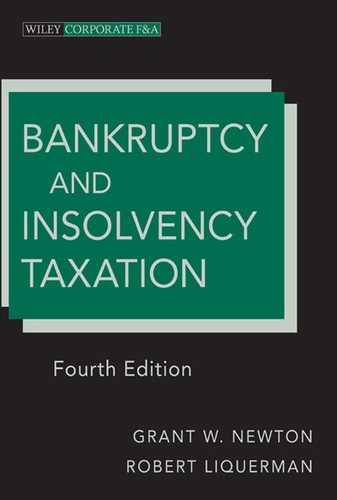Preface
THIS BOOK IS DESIGNED to provide a broad range of guidance on the tax aspects of decisions that must be made by companies in financial trouble. It will be useful to financial advisors, accountants, lawyers, trustees, turnaround professionals, examiners, creditors, bankruptcy judges, and debtors in possession.
The tax provisions of the Internal Revenue Code (I.R.C.) and the Bankruptcy Code applicable to businesses that have filed a chapter 7 or a chapter 11 bankruptcy petition are discussed in detail. Also explained are the provisions that apply to the debtor and its creditors. Special attention is given to the I.R.C. sections contained in the Tax Reform Act of 1980 and revisions of these sections by subsequent legislation, including the Tax Reform Act of 1984 and 1986, the Revenue Act of 1987, the Technical and Miscellaneous Revenue Act of 1988, the Revenue Reconciliation Act of 1990, the Omnibus Budget Reconciliation Act of 1993, Taxpayer Relief Act of 1977, the Job Creation and Worker Assistance Act of 2002, the American Jobs Creation Act of 2004, and the Bankruptcy Abuse Prevention and Consumer Protection Act of 2005 (2005 Act), as well as to recent nonstatutory changes in the tax law affecting troubled companies.
The first edition of Bankruptcy and Insolvency Taxation was a revision of Tax Planning for the Troubled Business, first published in 1983 and revised annually. The third edition was published in 2005. This edition, revising the third edition, will be updated annually or more frequently if needed because of tax law changes. In addition to Bankruptcy and Insolvency Taxation, John Wiley & Sons publishes Bankruptcy and Insolvency Accounting: Practice and Procedure and Bankruptcy and Insolvency Accounting: Forms and Exhibits written by one of the authors (Newton).
Chapter 1 describes the general provisions of the Bankruptcy Code applicable to debtors who have filed a chapter 7 or chapter 11 petition. Chapter 2 contains a discussion of the federal income tax consequences of debt discharge, including the exchange of stock for debt. Included is a description of Treasury regulations that deal with basis adjustment and debt modifications. Chapter 3 deals with the tax impact of an out-of-court workout or bankruptcy proceeding in a partnership or an S corporation, including a discussion of the Supreme Court decision in Gitlitz and subsequent legislation changes overturning Gitlitz. Chapter 4 examines the basic procedures that apply to the tax returns that must be filed by individuals, partners, and corporations in a chapter 7 or a chapter 11 case. The carryover of tax attributes, including regulations issued dealing with gain on sale of residence, to the estate of an individual debtor created when the bankruptcy petition is filed and the subsequent succession of the tax attributes by the debtor once the case has been completed are also explained.
Chapter 5 examines tax-free reorganizations under I.R.C. section 368, with special emphasis on type G reorganization, established by the Bankruptcy Tax Act of 1980. The use of net operating loss carryovers and other tax attributes by companies that go through a complete internal reorganization, or that are reorganized by the use of another corporation, is the subject of Chapter 6. Both Chapters 5 and 6 contain a detailed discussion of the many regulations and rules issued to implement the relevant provisions of the Internal Revenue Code.
Chapter 7 discusses several corporate tax topics not covered in previous chapters, including: liquidations, the use of I.R.C. section 338, incorporation under I.R.C. section 351, and the determination of whether an issue is debt or stock.
Chapter 8 deals with the state and local tax impact of income from debt discharge and related areas that are important for state and local tax purposes, including changes for state and local taxes contained in the 2005 Act.
Chapter 9 covers the tax impact that reorganization and income from debt discharge may have on the creditors.
Tax procedures are described in Chapter 10, tax priorities and discharge are examined in Chapter 11, and Chapter 12 contains a discussion of tax preferences and liens.
Chapters 2 through 7 and 9 through 12 have been updated to reflect cases that have been decided and pronouncements that have been issued by the IRS since the third edition was published.
Included in the appendices are relevant sections of the Internal Revenue Code and related sections of legislative history. These are available on the book’s companion Web site, www.wiley.com/go/bankruptcy4E.
The authors acknowledge the many contributions made by the previous coauthor Gilbert D. Bloom, Esq., in the Washington National Tax Practice of KPMG, LPP, over a period of almost 20 years beginning with the first volume published in 1983.
The authors appreciate the assistance provided by Amy Anderson, Christine Booth, Martin Euson, Greg Featherman, John Geracimos, Deanna Harris, Mark Hoffenberg, Alla Kashlinskaya, Nicholas Kato, David Madden, Jeffrey Vogel, Alex Yeadon, and Darin Zywan, all either currently or formerly in the Washington National Tax Practice of KPMG, LLP; Charles Rosen JD; Dennis Bean, Bean Hunt & Company; and Vernon L. Calder, Berkeley Research Group, LLC in preparing this edition.
Comments from users are welcomed.
Grant W. Newton
Robert Liquerman
January 2012
